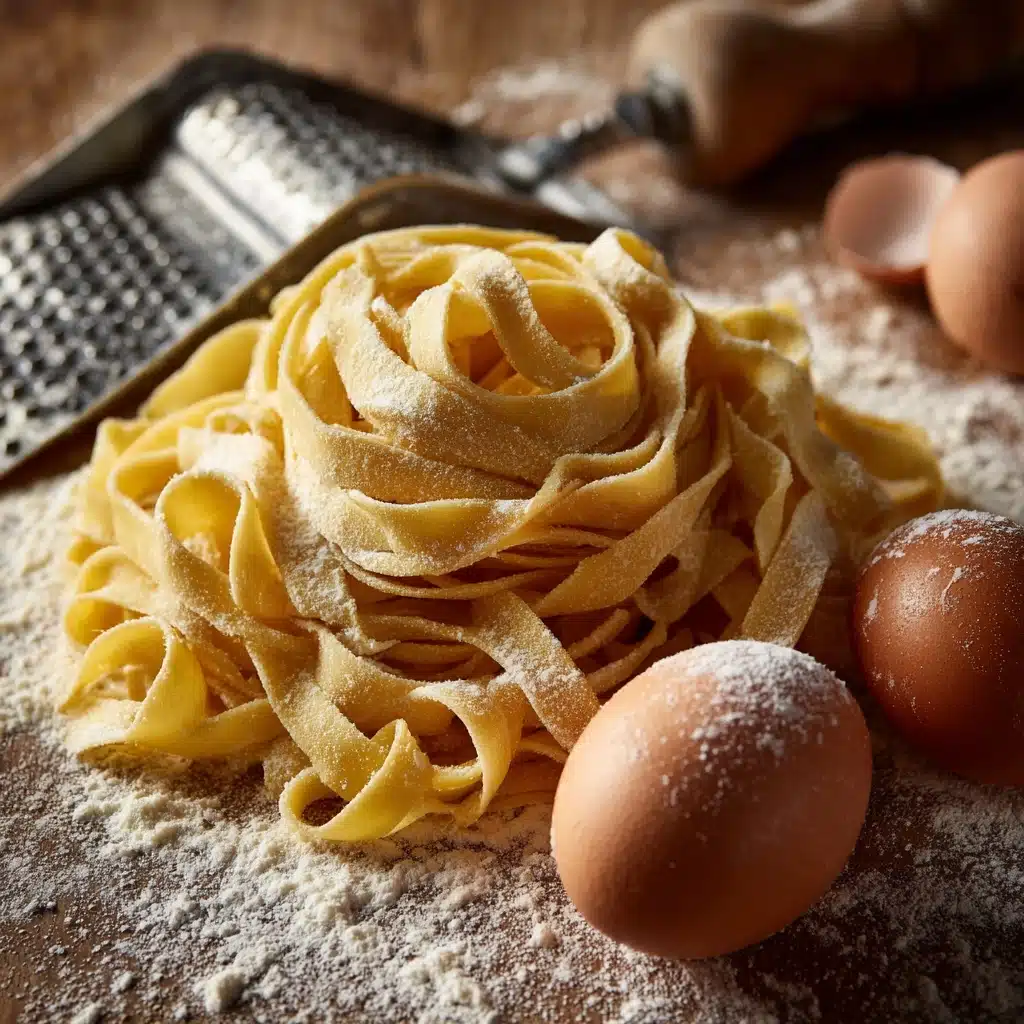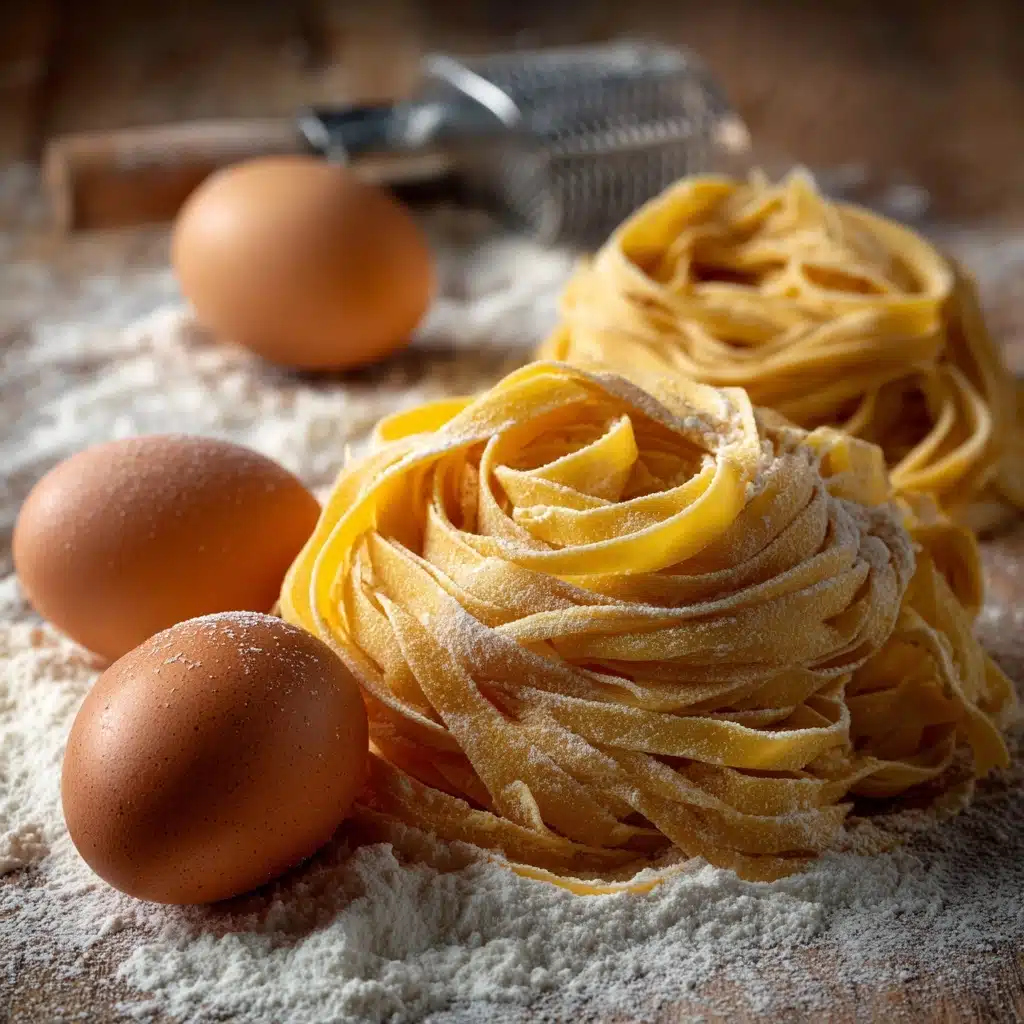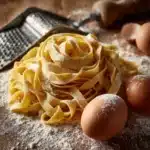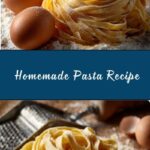There’s something absolutely magical about making Homemade Pasta from scratch—it’s a hands-on ritual that fills your kitchen with warmth and anticipation, while setting the stage for all sorts of fresh, flavorful meals. This classic Italian dish isn’t just about impeccable taste and delicate texture; it’s about turning simple ingredients into something totally memorable. Whether you’re shaping tender fettuccine or rolling out sheets for lasagna, every bite of Homemade Pasta captures that wholesome, nourishing joy you can’t find in any box.
Ingredients You’ll Need
Making fresh, Homemade Pasta requires just a handful of pantry staples, but each one plays a crucial role in creating that perfect bite. These ingredients come together effortlessly to give you pasta that’s beautifully structured, deliciously golden, and wonderfully silky.
- All-purpose flour: The backbone of Homemade Pasta, giving the dough enough structure while still keeping it supple and easy to work with.
- Large eggs: These bring richness and a natural golden hue; the higher the quality, the better your pasta will taste.
- Salt: Just a pinch brings out the flavor of the dough—don’t skip it!
- Olive oil (optional): A splash makes the dough easier to knead, and gives it that subtle Mediterranean aroma (totally worth trying at least once).
- Extra flour for dusting: Keeps the dough and your surfaces from sticking, especially when rolling and cutting.
How to Make Homemade Pasta
Step 1: Make a Flour Mound and Well
Start your Homemade Pasta adventure by pouring the flour onto a clean work surface or into a big mixing bowl. Shape it into a mound, then use your fingers or the back of a measuring cup to create a deep well in the center—you want enough space to comfortably cradle the eggs so they don’t spill out. This step feels delightfully old-fashioned, turning your kitchen into an Italian trattoria in minutes.
Step 2: Add Eggs, Salt, and Olive Oil
Crack the eggs directly into your flour well, sprinkle over the salt, and drizzle in the olive oil (if using). Now, take a fork and gently whisk the eggs together, slowly bringing a little flour in from the sides with each stir. Don’t rush—this gradual process is what helps your Homemade Pasta dough form smoothly, without lumps.
Step 3: Mix and Knead the Dough
As the dough begins to form a shaggy mass, put down the fork and use your hands to bring everything together. Scrape up any stray flour bits and knead the dough on your surface. You’re looking for a smooth, elastic texture—this can take 8 to 10 minutes, and it’s well worth the effort. If the dough feels sticky, dust it with a little more flour. If it’s too dry, a few drops of water will do the trick.
Step 4: Rest the Dough
Wrap your Homemade Pasta dough tightly in plastic wrap and let it rest at room temperature for about 30 minutes. This step is key: resting relaxes the gluten, making your dough easier to roll out and ensuring that beautiful silky texture in the final pasta.
Step 5: Roll and Cut the Pasta
Once rested, divide your dough into 2 to 4 pieces (this makes it easier to handle). Using a rolling pin or a pasta machine, roll each piece out to your desired thickness. Then, cut the dough into your preferred shapes—whether you’re craving fettuccine, tagliatelle, pappardelle, or sheets for lasagna, Homemade Pasta is all about personal preference. Remember to dust well with flour to prevent sticking!
Step 6: Cook and Serve
Bring a large pot of salted water to a rolling boil, then add your fresh pasta. It cooks incredibly fast—usually 2 to 4 minutes is all you need for that tender, al dente bite. Drain it, sauce it up however you like, and get ready for raves at the dinner table.
How to Serve Homemade Pasta
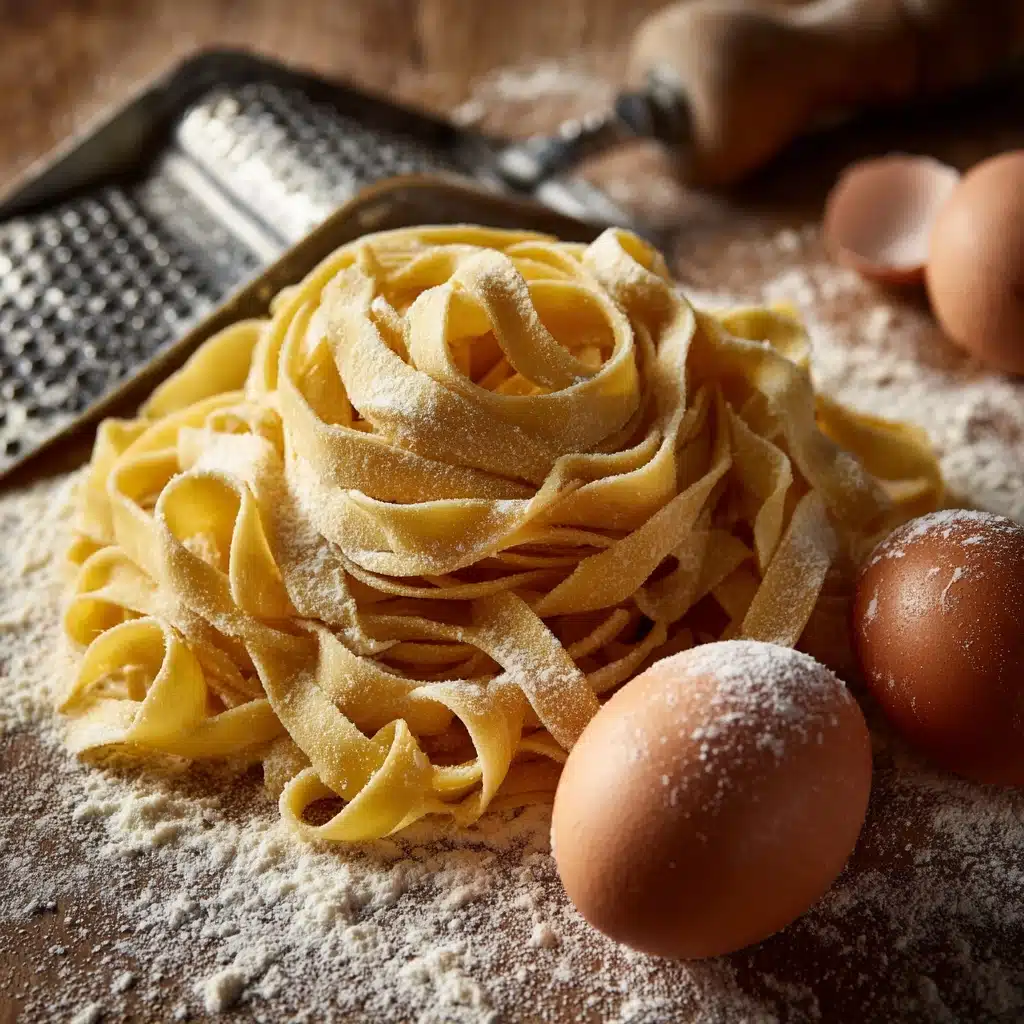
Garnishes
The beauty of Homemade Pasta is how a thoughtful garnish can turn it into a true showstopper. A handful of chopped fresh basil, a generous shower of grated parmesan, or a drizzle of fancy olive oil can all elevate your dish. Don’t forget a twist of black pepper or a sprinkle of chili flakes for those who love a bit of heat.
Side Dishes
Round out your Homemade Pasta meal with sides that complement its fresh flavors. Think a crisp green salad dressed with lemony vinaigrette, some blistered garlic bread for scooping up sauce, or simple roasted vegetables. These sides add balance and make your pasta dinner feel like a festive Italian feast.
Creative Ways to Present
For a fun presentation, try twirling the cooked pasta into neat little nests or stacking sheets with layers of sauce for a rustic, deconstructed lasagna. Homemade Pasta can also be portioned into individual bowls with colorful toppings—a real treat for family and guests alike.
Make Ahead and Storage
Storing Leftovers
If you find yourself with extra Homemade Pasta, let it cool before transferring to an airtight container. It keeps well in the fridge for up to 3 days, staying delightfully chewy and ready to pair with your favorite sauces.
Freezing
Want to plan ahead? Dust uncooked pasta with flour, shape it into small nests, and freeze them on a baking sheet before transferring to a freezer bag. They’ll keep beautifully for up to 2 months, perfect for last-minute pasta cravings.
Reheating
To reheat your Homemade Pasta, simply drop it into boiling water for 30 to 60 seconds or until warmed through. Alternatively, toss it in a hot pan with a splash of sauce or a bit of butter—this not only heats it up but adds even more flavor.
FAQs
Do I really need a pasta machine to make Homemade Pasta?
No machine required! While a pasta roller can help with ultra-thin sheets, a simple rolling pin works wonderfully. It just takes a bit more elbow grease and patience.
Can I use other types of flour for Homemade Pasta?
Yes, you can substitute some or all of the all-purpose flour with semolina or Italian 00 flour for different textures—a blend of these flours will give you a more traditional chewy bite or a silkier finish.
What’s the best way to keep my pasta from sticking?
Toss cut noodles in a generous dusting of flour as you shape them, and be sure your boiling water is well salted and vigorously bubbling before adding the pasta. This prevents clumping and ensures a perfect cook.
How do I know when fresh pasta is cooked?
Homemade Pasta cooks in just a few minutes. Check it after 2 minutes; it should be tender yet still have a slight bite (al dente). Taste-testing is always the best way to be sure!
Can I make Homemade Pasta dough in advance?
Definitely! You can make the dough up to a day ahead—just wrap it tightly and store it in the fridge. Bring it back to room temperature before rolling so it’s easy to work with.
Final Thoughts
If you haven’t given Homemade Pasta a try yet, now’s the perfect moment! Rolling and shaping your own pasta is so much fun, and the result is simply unbeatable. There’s something extra satisfying about watching a few simple ingredients become a plate of pure, Italian-inspired comfort. Give it a whirl—you might just start your own pasta-making tradition!
PrintHomemade Pasta Recipe
Learn how to make fresh homemade pasta from scratch with this easy recipe. With just a few simple ingredients, you can create delicious pasta that’s perfect for your favorite sauces.
- Prep Time: 20 minutes
- Cook Time: 3 minutes
- Total Time: 53 minutes (includes resting)
- Yield: 4 servings 1x
- Category: Main Course
- Method: Boiling
- Cuisine: Italian
- Diet: Vegetarian
Ingredients
All-Purpose Pasta Dough:
- 2 cups all-purpose flour (plus extra for dusting)
- 3 large eggs
- 1/2 teaspoon salt
- 1 tablespoon olive oil (optional)
Instructions
- Create the Dough: On a clean surface or in a large bowl, make a mound with the flour and create a well in the center. Crack the eggs into the well and add salt and olive oil if using. Using a fork, gently whisk the eggs, gradually incorporating the flour from the edges until a shaggy dough forms.
- Knead the Dough: Use your hands to bring the dough together and knead it for 8–10 minutes until smooth and elastic. Adjust with more flour or water as needed. Wrap the dough tightly in plastic wrap and let rest for 30 minutes.
- Roll and Shape: Divide the dough into pieces, roll them out to your desired thickness, and cut into your preferred shape. Dust with flour to prevent sticking.
- Cook the Pasta: Boil salted water, add the pasta, and cook for 2–4 minutes until al dente. Drain and serve with your favorite sauce.
Notes
- You can freeze uncooked pasta in floured nests for up to 2 months.
- Semolina flour can be substituted for a firmer bite, or use a mix of all-purpose and 00 flour for a silkier texture.
Nutrition
- Serving Size: 1 cup cooked pasta
- Calories: 210
- Sugar: 1g
- Sodium: 115mg
- Fat: 4g
- Saturated Fat: 1g
- Unsaturated Fat: 2g
- Trans Fat: 0g
- Carbohydrates: 34g
- Fiber: 1g
- Protein: 8g
- Cholesterol: 105mg

